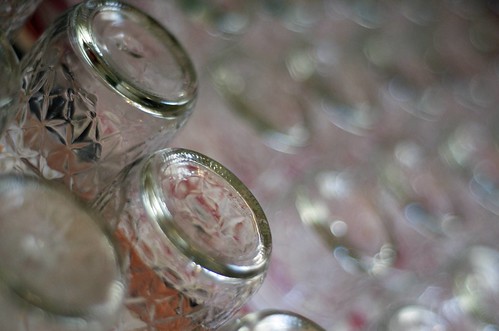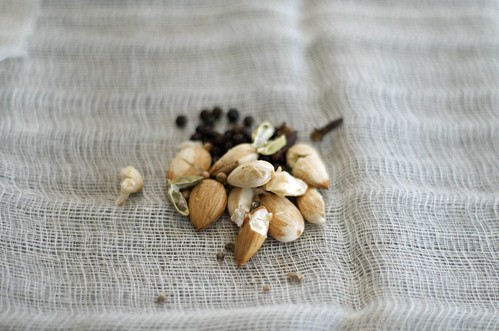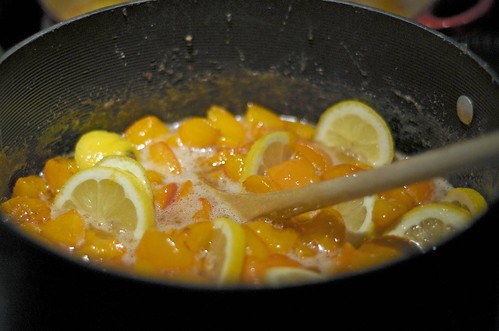Apricot jam with noyaux, spices and bourbon
Preface: I know perfectly well that canning fruit jam will not produce botulism. It's called humor.
Cooking is much more than just producing food for sustenance. Itis at once intimate and objective, creative and logistical. But above all else, it is personal. Even the most basic home-cooked dish is in some way an expression of you as a person, your technical expertise, your sense of adventure, your cultural heritage.
This is why food and its preparation are best shared. Whether you are giving someone a recipe or just soliciting for an extra hand in the kitchen, your kitchen becomes your own personal town hall.
And so when my friend Vanessa expressed interested in doing some jamming and canning with me, I was more than thrilled to oblige. The apricots are finally coming into season, and I've been jonesing for more since I opened my last jar of last year's batch during the winter.
Vanessa gamely showed up with a 26-lb. flat of apricots, some organic lemons and a desire to jam. I had jars at the ready. We set to work right away.
Handling apricots, whether for jam or eating out of hand, is an intensely sensual experience. Sitting softly in the palm of your hand, they seem to have an intrinsic warmth. The flesh yields with the gentlest tug from your thumbs at the seam where the fuzzy cheeks meet; honeyed droplets form along the walls of the exposed interior. The stone surrenders itself without resistance. The fruit, once curled into itself, is now splayed out, naked, yours for the taking.
Ahem. Where was I? Oh, right. Jam.
As we ravaged our apricots, we reserved the pits in a separate bowl, for they were our secret ingredient. You see, inside the practically impenetrable pits of stone fruits are tender little seeds called noyaux that, when steeped in liquid, impart a haunting almond-like aroma. Why? Because they are packed with cyanide! In very small quantities, though, they are merely delicious and not deadly.
So, as we prepared to start the first batch, we cracked open our pits and made little sachets with a few other flavor-enhancing spices: Black pepper, cardamom and clove.
These went into two pots full of fruit, sugar and lemons.
Knowing we would have to process the fruit in two batches of two pots each, I set the first batch on a high flame to get things started, while Vanessa continued breaking down the remaining fruit. Moments later something caught the corner of my eye, at which point my head turned to see brown bubbles rising from one side of one of the pots. The sugar was burning! I quickly gave the pot a stir, hoping I hadn't ruined the whole thing. As liquid from the macerated fruit mixed with the brown sugar, the room filled with the rich, nutty smell of caramel. No black bits appeared. So, we ended up making one whole pot of caramel apricot jam. Totally on purpose.
I decided to use lemons this time in lieu of commercial pectin. In the past, I've found that apricots tend to break down a fair amount on their own, and naturally create a thickened jam; the pectin from the lemon rind would just help move that along.
As the jam came to temperature, I walked Vanessa through the workflow of canning: Sterilize the jars and lids, fill the jars, add the lids and rings, place in the waterbath for ten minutes, then remove to cool. I explained the importance of each step: If the jars are not sterilized, you will get botulism. If you touch the inside of the sterilized jars, thereby rendering themno longer sterile, you will get botulism. If the lids do not form a good seal, you will get botulism. I think she got the point.
We ladled the jam into the jars, the afternoon light causing them to glow a bright, golden orange. I called it the color of happiness. It just makes you smile.
Once we pulled our final product out of the water bath, we were tickled by the effervescent pop-pop-pop of lids compressing. It can be hard work, but canning is very gratifying. You feel productive.
In the end we filled 24 cup jars, 24 half-pint jars and more than a dozen pint jars; the pint jars were filled with our second batch. Interestingly, though we didn't vary our methods, the latter half of our jams just didn't set up quite as well. In the end, I decided to hold them back and reprocess them with additional pectin later on.
This is the other reason I like cooking: It's OK to fail, because you learn from your failures. You learn to adapt. And you learn that nothing that's been done can't be undone or redone.
Unless you get botulism.
Apricot jam with noyaux, spices and bourbon
1000 g. (about 7 c.) apricots, coarsely chopped, pits reserved
1000 g. (about 5 c.) sugar
One lemon, cut in slices
5-7 black peppercorns
1-2 cardamom pods, cracked
2-3 cloves
1/4 c. bourbon
In a large, heavy, nonreactive pot, mix the fruit and sugar, and let stand to macerate at least 20 minutes.
With a nutcracker, crack open several of the reserved pits and remove the noyaux from within. Don't worry if they get a little beat up. On a square of cheesecloth (approximately 6" square), place the noyaux and spices, and tie up the corners tightly to form a sachet.
Place the macerated fruit over medium heat until all the sugar is dissolved (unless you're on purpose going for caramelized apricot jam, in which case crank it up! Carefully.) Add the lemons and the sachet. Raise the heat to high, stirring frequently to prevent burning.
When the jam reaches 220ºF, turn off the flame, add the bourbon, stir will to combine and let the jam stand for a few minutes. Ladle through a canning funnel into sterilized jars, leaving 1/2" headroom. Give the jars a jiggle to release any bubbles in the jam. Clean away any jam on the lip of the jars with a moistened paper towel, being careful not to touch the interior of the jar. Cover with new, unused lids and add the rings, tightening until finger-tight. Lower into a water bath at a full, rolling boil with at least 1" water above the tops of the jars, and boil for at least five minutes. (If you are more than 1000 feet above sea level, you will need to adjust your boiling times by adding one minute for every 1000 feet in altitude.)
Remove the jars to cooling racks. Smile as the lids go pop-pop-pop. If any do not, keep them in the refrigerator and consume at will, or reprocess and can as above.





